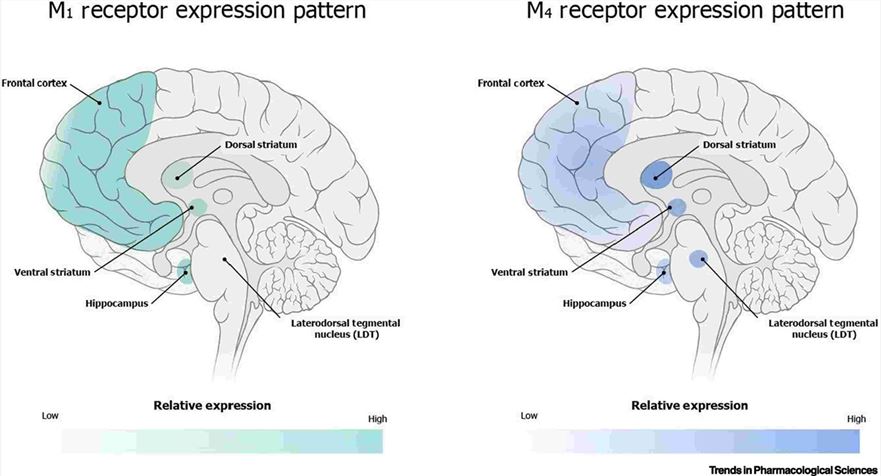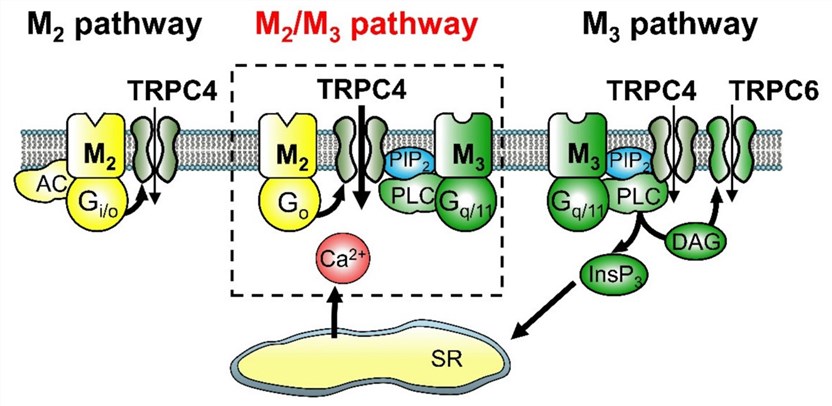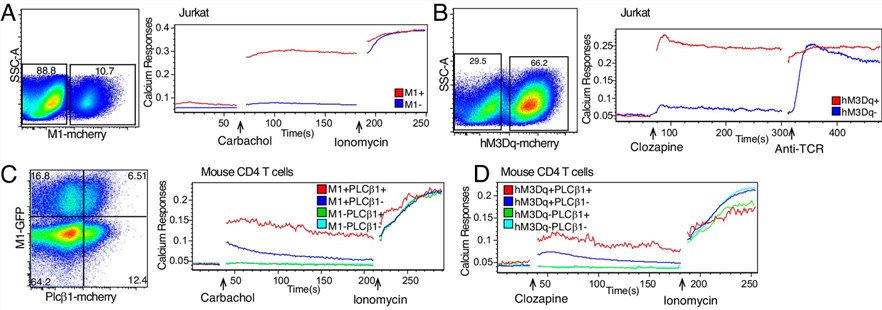Hi-Affi™ In Vitro Cell based Muscarinic Receptor Functional Assay Service
The Importance of Muscarinic Receptors
Muscarinic receptors are GPCRs that play a role in the parasympathetic nervous system. They consist of M1, M2, M3, M4, and M5 receptor subtypes, which are implicated in several physiological processes like peristalsis, micturition, and others. Several widespread illnesses, such as chronic obstructive pulmonary disease and asthma, are closely linked with dysfunctional muscarinic receptors. Targeting muscarinic receptors in the affected area is meaningful for the treatment of a variety of associated diseases. Accordingly, identifying muscarinic receptors may aid in the drug development of diseases.
 Fig.1 M1 and M4 muscarinic acetylcholine receptors (mAChRs) expression in brain areas associated with psychosis.1
Fig.1 M1 and M4 muscarinic acetylcholine receptors (mAChRs) expression in brain areas associated with psychosis.1
Our Hi-Affi™ In Vitro Cell-based Muscarinic Receptor Functional Assay Service
Surprisingly, Creative Biolabs has innovatively developed a cost-effective Hi-Affi™ in vitro cell-based muscarinic receptor functional assay service and welcomes global customers to inquire and order.
Our Hi-Affi™ in vitro cell-based muscarinic receptor functional assay service incorporates a straightforward and efficient cell-based assay with muscarinic receptors functional assay that has the potential to be utilized to evaluate candidate samples and their capability to modulate muscarinic receptors. The principle of this assay is to examine the diacyl flux and calcium flux in response to G protein activation triggered by muscarinic receptors binding to ligands. During every stage of this procedure, our comprehensive, customized, and exceptional services will enable the diverse demands of global customers to be met.
 Fig.2 Three distinct muscarinic signaling pathways leading to transient receptor potential (TRP)-like cationic channel opening in ileal myocytes.2
Fig.2 Three distinct muscarinic signaling pathways leading to transient receptor potential (TRP)-like cationic channel opening in ileal myocytes.2
How to Work: End-to-end Custom Service
Stage 1: Cell-Based Assay Setup
- Selection and preparation of appropriate cell lines expressing muscarinic receptors.
Stage 2: Candidate Sample Evaluation
- Introduction and testing of candidate samples to observe their interaction with the muscarinic receptors.
Stage 3: Measurement of Calcium Flux or cAMP
- Monitoring and quantifying changes in calcium and cAMP levels within the cells, which are indicators of G protein activation in response to the samples.
Stage 4: Analysis of Muscarinic Receptor Modulation
- Interpreting the measured flux data to determine the modulatory effects of the candidate samples on the muscarinic receptors.
Analyzable Muscarinic Receptors at Creative Biolabs
Our service is designed to analyze four subtypes of muscarinic acetylcholine receptors (mAChRs):
- Muscarinic Receptor 1 (CHRM1)
- Muscarinic Receptor 3 (CHRM3)
- Muscarinic Receptor 4 (CHRM4)
- Muscarinic Receptor 5 (CHRM5)
Our Features
Our integrated Hi-Affi™ in vitro cell-based muscarinic receptor functional assay service overcomes the limits of traditional muscarinic receptor functional assays and has succeeded in achieving innovative developments in technology, applications, and other aspects. Our integrated Hi-Affi™ in vitro cell-based muscarinic receptor functional assay service can deliver significant benefits to global customers:
- Multiple strains of cell lines to choose from for global customers.
- Efficient and dependable experimental setups to be equipped for all projects.
- Competent research teams to guarantee the successful completion of all projects.
- One-stop customized services to empower our Hi-Affi™ in vitro cell-based muscarinic receptor functional assay service.

Case Study
Representative Data 1: The cellular signaling and roles of two categories of muscarinic receptors, M1 (flag epitope-tagged) and hM3Dq (HA epitope-tagged), in Jurkat leukemic T cells may be activated by carbachol or clozapine, respectively. The results show that muscarinic receptor stimulation caused substantial calcium responses in Jurkat cells. When either muscarinic receptor was retrovirally transduced into primary mouse T cells, it was seen that both receptors were sensitive to stimulation, at least in terms of calcium increases, with carbachol or clozapine, respectively. In addition, transduction of PLCβ1, a vital mediator of response to superantigens in Jurkat cells, could strongly improve responses to stimulated muscarinic receptors in mouse T cells. Consequently, they demonstrated that co-expression of PLCβ1 and stimulation of M1 and synthetic hM3Dq receptors may activate primary murine T cells.
 Fig.3 PLCβ1 significantly improves calcium responses in primary T cells with active muscarinic receptors.3
Fig.3 PLCβ1 significantly improves calcium responses in primary T cells with active muscarinic receptors.3
Frequently Asked Questions
-
Q1: What readouts do you typically use for these assays?
A1: The most common readouts for muscarinic receptor functional assays include:
- Calcium Mobilization: Muscarinic M1, M3, and M5 receptors are primarily coupled to Gq proteins, leading to the activation of phospholipase C (PLC) and subsequent release of intracellular calcium. Calcium flux can be measured using fluorescent calcium indicators.
- cAMP Accumulation: Muscarinic M2 and M4 receptors are largely associated with Gi/o proteins, which limit adenylyl cyclase activity and reduce intracellular cyclic AMP (cAMP) levels. Conversely, antagonists can reverse agonist-induced cAMP inhibition.
-
Q2: What kind of compounds can be tested?
A2: We can test a wide range of compounds, including: small molecule libraries; known agonists, antagonists, and allosteric modulators; peptides; and natural product extracts.
-
Q3: What information do I need to provide for a service request?
A3: To ensure a smooth and efficient service, please provide the following information:
- Compound details: Name, structure (if available), purity, concentration, and any specific handling instructions (e.g., light sensitivity, storage temperature).
- Target receptor subtype(s): Specify which muscarinic receptor(s) you are interested in.
- Assay type: Agonist screening, antagonist screening, dose-response curves for EC50/IC50 determination, etc.
- Desired data analysis: EC50, IC50, Ki, Emax, etc.
- Any specific experimental requirements or controls.
- Number of compounds and replicates.
-
Q4: Can you customize the assay for my specific needs?
A4: Yes, we offer flexible and customizable assay solutions. We can optimize assay conditions, develop specific cell lines, or adapt readouts to meet your unique research objectives. Please discuss your specific requirements with our scientific team.
Work with Creative Biolabs
Constantly, in response to customers' feedback, Creative Biolabs endeavors the develop and improve technological innovations. For more details about our Hi-Affi™ in vitro cell-based muscarinic receptor functional assay service, please don't hesitate to contact us. We are eagerly anticipating forging long-term partnerships with customers all across the world.
References
-
Yohn, Samantha E., et al. "Muscarinic acetylcholine receptors for psychotic disorders: bench-side to clinic." Trends in Pharmacological Sciences 43.12 (2022): 1098-1112.
Distributed under Open Access License CC BY 4.0, without modification. -
Tanahashi, Yasuyuki, et al. "Functions of muscarinic receptor subtypes in gastrointestinal smooth muscle: A review of studies with receptor-knockout mice." International Journal of Molecular Sciences 22.2 (2021): 926.
Distributed under Open Access License CC BY 4.0, without modification. -
Nguyen, Trang TT, et al. "Stimulation of ectopically expressed muscarinic receptors induces IFN-γ but suppresses IL-2 production by inhibiting activation of pAKT pathways in primary T cells." Proceedings of the National Academy of Sciences 120.25 (2023): e2300987120.
Distributed under Open Access License CC BY 4.0, without modification.
For Research Use Only.
